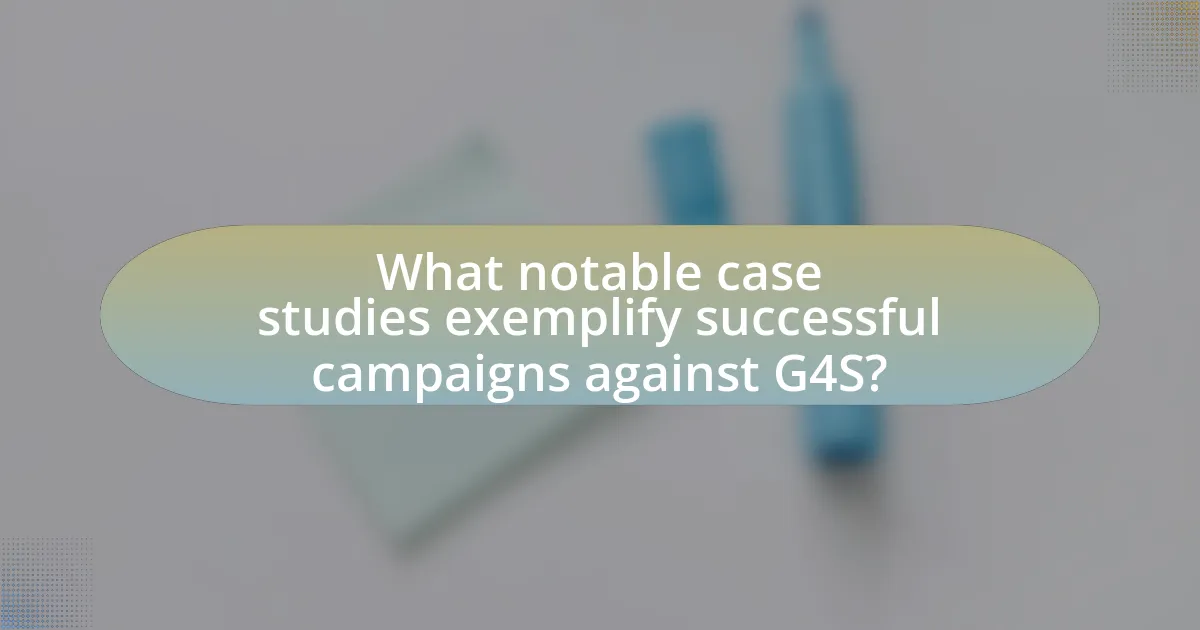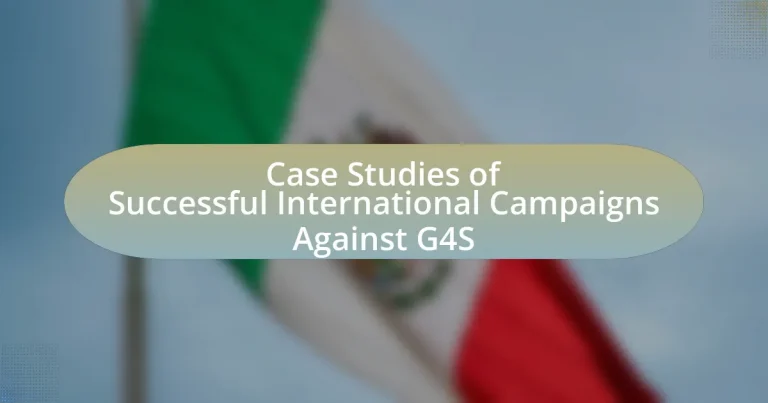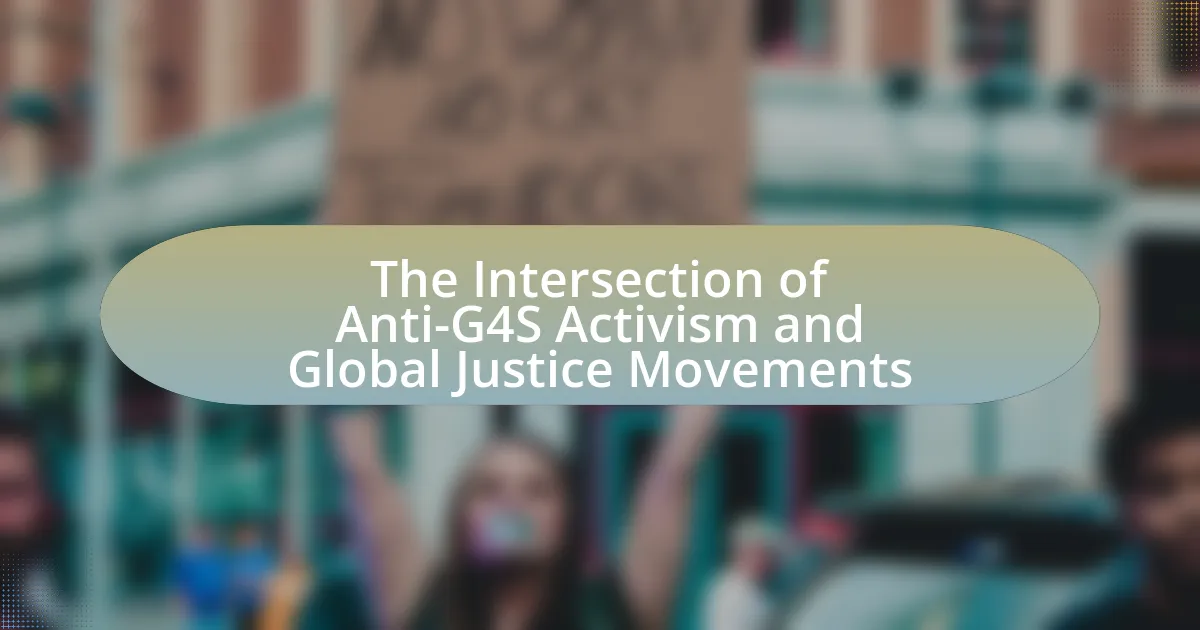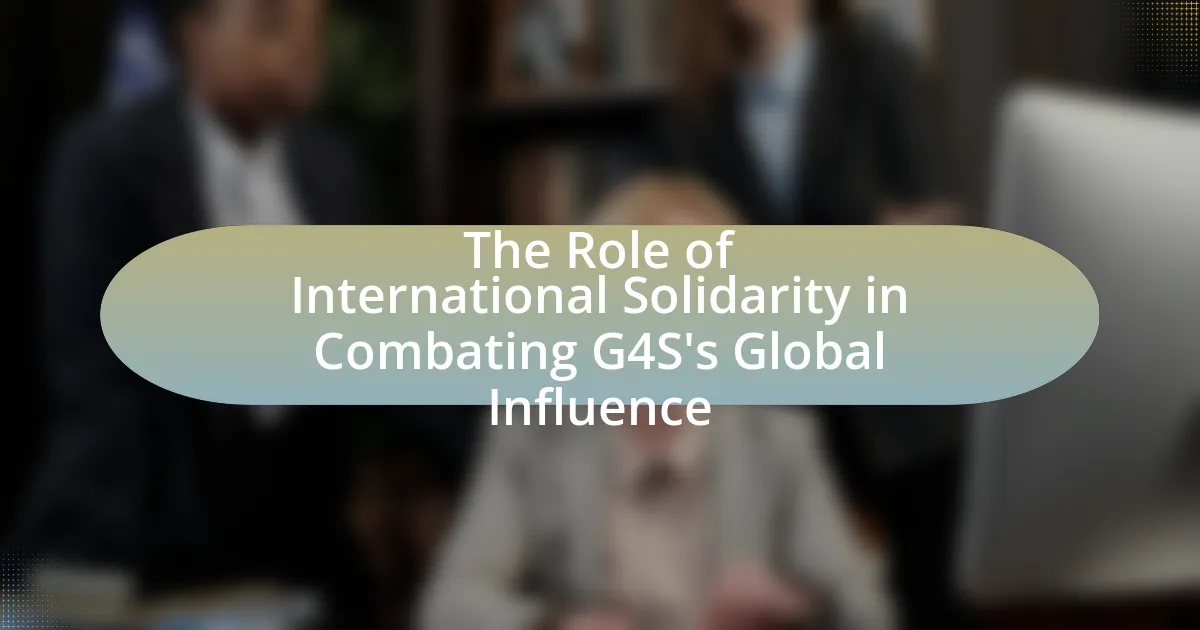The article focuses on successful international campaigns against G4S, a private security company often criticized for its involvement in human rights violations. It outlines key elements of these campaigns, including coalition-building, effective communication, and targeted advocacy, which have mobilized public awareness and pressured decision-makers. Various organizations, such as Amnesty International and the Boycott, Divestment, Sanctions (BDS) movement, have employed strategies like grassroots mobilization and strategic partnerships to challenge G4S’s practices. The article also highlights notable case studies, such as the “Boycott G4S” and “Stop G4S” campaigns, detailing their impact on corporate accountability and the lessons learned for future activism.

What are the key elements of successful international campaigns against G4S?
Successful international campaigns against G4S typically include strategic coalition-building, effective communication, targeted advocacy, and leveraging public awareness. Coalition-building involves uniting various stakeholders, such as human rights organizations, labor unions, and community groups, to amplify the campaign’s reach and impact. Effective communication ensures that the campaign’s message resonates with diverse audiences, utilizing social media, press releases, and public events to raise awareness about G4S’s controversial practices. Targeted advocacy focuses on specific issues, such as G4S’s involvement in the Israeli-Palestinian conflict or its role in privatized detention centers, to mobilize support and pressure decision-makers. Leveraging public awareness through grassroots mobilization and high-profile endorsements can significantly increase pressure on G4S, as seen in campaigns that have successfully led to contract cancellations and public scrutiny of the company’s operations.
How have various organizations approached campaigns against G4S?
Various organizations have approached campaigns against G4S through coordinated advocacy, public awareness initiatives, and strategic partnerships. For instance, groups like Amnesty International and the Boycott, Divestment, Sanctions (BDS) movement have highlighted G4S’s involvement in human rights violations, particularly in relation to its contracts with Israeli security services. These organizations have utilized social media campaigns, protests, and shareholder resolutions to pressure G4S to end its contracts in occupied territories. Additionally, labor unions and student organizations have organized divestment campaigns, urging institutions to withdraw investments from G4S, thereby amplifying the call for accountability. This multifaceted approach has led to significant public discourse and has pressured G4S to reconsider its business practices in response to growing scrutiny.
What strategies have proven effective in these campaigns?
Effective strategies in campaigns against G4S include grassroots mobilization, strategic partnerships, and targeted media outreach. Grassroots mobilization has empowered local communities to organize protests and raise awareness, exemplified by the Boycott G4S campaign, which successfully engaged thousands of activists globally. Strategic partnerships with human rights organizations, such as Amnesty International, have amplified the campaigns’ reach and credibility, leveraging their established networks to advocate against G4S’s practices. Targeted media outreach has been crucial in shaping public perception, as seen in the extensive coverage of G4S’s involvement in controversial issues, which has led to increased scrutiny and pressure on the company. These strategies collectively demonstrate a multifaceted approach that effectively challenges G4S’s operations and policies.
What role does public awareness play in these campaigns?
Public awareness is crucial in campaigns against G4S as it mobilizes public opinion and drives action. Increased awareness leads to greater public scrutiny of G4S’s practices, influencing stakeholders and policymakers. For instance, campaigns that effectively raised awareness about human rights violations associated with G4S operations resulted in significant public backlash, leading to contract cancellations by various institutions. This demonstrates that informed public sentiment can directly impact corporate accountability and operational practices.
What are the common goals of these campaigns?
The common goals of campaigns against G4S include raising awareness about human rights violations, advocating for corporate accountability, and promoting ethical business practices. These campaigns aim to inform the public and stakeholders about G4S’s involvement in controversial activities, such as operating in conflict zones and providing security services in detention centers. By mobilizing public opinion and leveraging social media, these campaigns seek to pressure G4S to change its policies and practices, ultimately striving for a more just and equitable treatment of affected communities.
How do these goals align with broader social justice movements?
The goals of campaigns against G4S align with broader social justice movements by advocating for human rights, equity, and accountability in the private security industry. These campaigns highlight issues such as the treatment of marginalized communities, labor rights, and the impact of privatization on public services, which resonate with the objectives of social justice movements that seek to dismantle systemic inequalities. For instance, the Boycott, Divestment, Sanctions (BDS) movement against G4S emphasizes the company’s role in supporting Israeli military operations, linking it to global struggles against colonialism and oppression. This connection illustrates how the fight against G4S is part of a larger narrative advocating for justice, dignity, and respect for all individuals, reinforcing the interdependence of various social justice efforts.
What specific changes do these campaigns seek to achieve?
These campaigns seek to achieve significant reforms in the operations and practices of G4S, particularly regarding human rights and labor conditions. The primary objectives include ending the company’s involvement in controversial activities such as immigration detention and privatized policing, as well as improving transparency and accountability in its operations. For instance, campaigns have successfully pressured G4S to withdraw from contracts linked to human rights abuses, demonstrating the effectiveness of collective action in influencing corporate behavior.

What notable case studies exemplify successful campaigns against G4S?
Notable case studies exemplifying successful campaigns against G4S include the “Boycott G4S” campaign initiated by various human rights organizations, which successfully pressured institutions like the University of California to divest from G4S due to its involvement in the Israeli occupation of Palestinian territories. This campaign highlighted G4S’s role in operating security systems in Israeli prisons and settlements, leading to significant public awareness and institutional action against the company. Additionally, the “Stop G4S” campaign in the UK mobilized protests and advocacy efforts that resulted in several local councils and universities terminating contracts with G4S, demonstrating the effectiveness of grassroots activism in challenging corporate practices linked to human rights violations.
What was the impact of the ‘Boycott G4S’ campaign?
The ‘Boycott G4S’ campaign significantly impacted the company’s reputation and operations, leading to increased scrutiny and pressure on its contracts, particularly in relation to its involvement in Israel and Palestine. The campaign mobilized activists globally, resulting in numerous organizations and institutions severing ties with G4S, including universities and pension funds. This collective action highlighted human rights concerns associated with G4S’s operations, contributing to a broader discourse on corporate accountability in conflict zones. The campaign’s effectiveness is evidenced by G4S’s decision to sell its Israeli subsidiary in 2016, indicating a direct response to the mounting pressure from the boycott.
What strategies were employed in the ‘Boycott G4S’ campaign?
The ‘Boycott G4S’ campaign employed strategies such as grassroots mobilization, public awareness campaigns, and coalition-building among various organizations. Grassroots mobilization involved engaging local communities and activists to spread the message and encourage participation in the boycott. Public awareness campaigns utilized social media, protests, and educational events to inform the public about G4S’s involvement in human rights violations, particularly in relation to the Israeli occupation of Palestine. Coalition-building included partnerships with human rights organizations, student groups, and faith-based communities to amplify the campaign’s reach and impact. These strategies collectively aimed to pressure G4S by highlighting its controversial practices and encouraging consumers and institutions to withdraw support.
What outcomes were achieved as a result of this campaign?
The campaign against G4S achieved significant outcomes, including increased public awareness of human rights violations associated with the company’s operations. This heightened awareness led to a decline in G4S’s contracts with various institutions, as evidenced by the cancellation of contracts in multiple countries, including the UK and South Africa. Additionally, the campaign successfully mobilized grassroots support, resulting in protests and advocacy efforts that pressured governments and organizations to reconsider their partnerships with G4S. These outcomes demonstrate the campaign’s effectiveness in influencing public opinion and policy regarding corporate accountability in human rights issues.
How did the ‘Stop G4S’ campaign gain traction?
The ‘Stop G4S’ campaign gained traction through strategic grassroots mobilization and widespread public awareness efforts. Activists utilized social media platforms to disseminate information about G4S’s involvement in controversial practices, such as operating in Israeli prisons and providing security for the Israeli military. This digital outreach was complemented by organized protests, educational events, and partnerships with various human rights organizations, which collectively amplified the campaign’s message. The campaign’s effectiveness was evidenced by increased media coverage and growing support from influential figures and organizations, leading to significant public discourse around G4S’s operations and ethical implications.
What tactics were used to mobilize support for the ‘Stop G4S’ campaign?
The ‘Stop G4S’ campaign mobilized support through grassroots organizing, strategic partnerships, and targeted awareness-raising activities. Grassroots organizing involved local activists and organizations conducting protests, demonstrations, and public events to raise awareness about G4S’s controversial practices, particularly in relation to human rights violations. Strategic partnerships with various NGOs and community groups amplified the campaign’s reach and credibility, allowing for a broader coalition against G4S. Targeted awareness-raising activities included social media campaigns, educational workshops, and the dissemination of informational materials that highlighted G4S’s involvement in issues such as the Israeli occupation and privatization of public services. These tactics collectively fostered a strong, informed base of support for the campaign.
What were the key successes and challenges faced by this campaign?
The key successes of the campaign against G4S included raising global awareness about human rights violations associated with the company and successfully mobilizing public support, which led to significant divestment from G4S by various institutions. For instance, the campaign resulted in over 30 universities and pension funds withdrawing their investments, demonstrating a tangible impact on G4S’s financial standing.
Conversely, the challenges faced by the campaign included overcoming G4S’s extensive lobbying efforts and public relations strategies aimed at discrediting the campaign’s claims. Additionally, the campaign struggled with internal divisions among activist groups, which sometimes diluted their messaging and effectiveness. These challenges hindered the campaign’s ability to maintain momentum and achieve broader systemic change.

What lessons can be learned from these campaigns against G4S?
The campaigns against G4S demonstrate the effectiveness of grassroots mobilization and strategic advocacy in influencing corporate behavior. These campaigns successfully highlighted human rights violations associated with G4S operations, leading to significant public pressure and changes in corporate policies. For instance, the Boycott G4S campaign, which gained traction in various countries, resulted in several institutions severing ties with G4S due to its involvement in controversial practices, such as operating in Israeli prisons. This illustrates that sustained public awareness and coalition-building can lead to tangible outcomes, including financial repercussions for companies that engage in unethical practices.
What best practices emerged from successful campaigns?
Best practices that emerged from successful campaigns against G4S include strategic coalition-building, effective use of social media, and targeted messaging. Strategic coalition-building involved uniting various organizations and stakeholders to amplify the campaign’s reach and impact, as seen in the collaboration between human rights groups and labor unions. Effective use of social media allowed campaigns to engage a broader audience, mobilize supporters quickly, and share real-time updates, which was crucial in raising awareness and driving action. Targeted messaging focused on specific issues related to G4S’s operations, such as human rights violations and labor practices, which resonated with the public and garnered support. These practices were validated by the increased visibility and pressure on G4S, leading to significant changes in public perception and corporate accountability.
How can future campaigns apply these best practices?
Future campaigns can apply best practices by leveraging data-driven strategies, engaging diverse stakeholders, and utilizing multi-channel communication. For instance, successful campaigns against G4S have demonstrated the effectiveness of targeted messaging that resonates with specific audiences, as seen in the “Boycott G4S” campaign, which mobilized grassroots support through social media and community outreach. Additionally, employing transparency in objectives and outcomes fosters trust and encourages participation, as evidenced by the clear communication strategies used in campaigns that resulted in significant public awareness and policy changes. These practices are validated by the measurable impact of previous campaigns, which have led to increased public engagement and shifts in corporate accountability.
What common pitfalls should be avoided in similar campaigns?
Common pitfalls to avoid in campaigns against organizations like G4S include lack of clear messaging, insufficient stakeholder engagement, and failure to adapt strategies based on feedback. Clear messaging is crucial; campaigns that lack focus often confuse audiences and dilute impact. For instance, the “Boycott G4S” campaign faced challenges due to mixed messages about its goals, which hindered public support. Engaging stakeholders, including affected communities and allies, is essential; campaigns that overlook this risk alienating key supporters. Lastly, campaigns must remain flexible; those that do not adjust their strategies in response to public sentiment or operational challenges often struggle to maintain momentum.
How can activists effectively engage communities in campaigns against G4S?
Activists can effectively engage communities in campaigns against G4S by utilizing grassroots organizing, building coalitions, and leveraging social media for awareness. Grassroots organizing involves mobilizing local residents to participate in actions, such as protests or community meetings, which fosters a sense of ownership and urgency regarding the issues associated with G4S. Building coalitions with other organizations, such as labor unions and human rights groups, amplifies the campaign’s reach and resources, as seen in the successful campaigns in the UK where diverse groups united against G4S’s involvement in detention centers. Additionally, leveraging social media platforms allows activists to disseminate information quickly, share personal stories, and create viral campaigns that resonate with broader audiences, as demonstrated by the #StopG4S movement that gained traction online. These strategies collectively enhance community engagement and mobilization against G4S.
What methods can be used to raise awareness and build coalitions?
To raise awareness and build coalitions, organizations can utilize social media campaigns, community engagement initiatives, and strategic partnerships. Social media campaigns effectively disseminate information to a broad audience, as evidenced by the #BlackLivesMatter movement, which mobilized global support through online platforms. Community engagement initiatives, such as workshops and public forums, foster local involvement and create a sense of ownership among participants, similar to the grassroots efforts seen in the anti-apartheid movement. Strategic partnerships with other organizations amplify resources and reach, as demonstrated by the collaboration between various human rights groups in campaigns against G4S, which enhanced visibility and impact.
How can grassroots movements sustain momentum over time?
Grassroots movements can sustain momentum over time by fostering strong community engagement and maintaining clear communication channels. Engaging community members through regular meetings, social media updates, and collaborative events helps to build a sense of ownership and commitment among participants. For instance, the Black Lives Matter movement has effectively utilized social media to keep supporters informed and mobilized, resulting in sustained activism over several years. Additionally, establishing partnerships with other organizations can amplify resources and reach, as seen in various campaigns against G4S, where alliances with human rights groups have strengthened advocacy efforts. Regularly celebrating small victories also reinforces motivation and encourages continued participation, as demonstrated by successful campaigns that highlight incremental progress towards larger goals.
What practical tips can enhance the effectiveness of campaigns against G4S?
To enhance the effectiveness of campaigns against G4S, organizations should focus on building coalitions with other advocacy groups to amplify their message. Collaborating with diverse stakeholders increases visibility and resources, as seen in the successful campaigns led by groups like the International Trade Union Confederation, which united various labor organizations to challenge G4S’s practices. Additionally, utilizing social media strategically can mobilize public support and raise awareness, as demonstrated by campaigns that effectively used platforms like Twitter and Facebook to share information and engage audiences. Targeting specific G4S contracts or operations for focused campaigns can also yield results, as evidenced by the successful efforts to pressure universities to divest from G4S contracts, which led to significant financial repercussions for the company.





